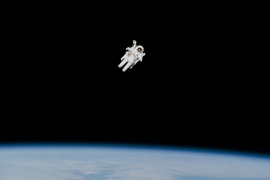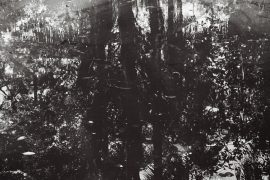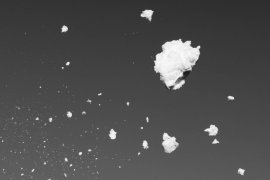THE LAST PRESIDENT OF THE UNITED STATES IS ABOUT TO PERFORM. It will be a kind of happening in the style of the late twentieth century. Something physical yet conceptual, symbolic or just nonsensical. Something boisterous, eye-catching, yet suggesting a deeper truth to be pondered.
The last president of the United States. . . . You get which—the tall, young, athletic and slim, head as oval as the room where he pondered options and came to conclusions. Those Arthurian days of confabulation are gone. The last president has been home for a while—his mandate exhausted. Still his fame persists. His public appearances draw a remarkable crowd.
***
The performance will be mediatized. I see lots of machinery and a plethora of professionals, pacing, intent—mostly wearing raincoats, yellow, orange. It does not look like rain. I hear the booming voice of an anchorman, as distinct (diffused, omnipresent) as the voice of god might well be.
“The last president,” he shouts, “has always been fond of dismantling cages . . . he would not miss the occasion of taking one such apart.” Is the statement ironic? Hard to say when it comes to journalistic eloquence.
***
He has arrived unnoticed, hopping sideways on stage. A small boat (did he actually row?) has led him to a platform of concrete surrounded by water. In the background are mountains—hazy, blurred, non-descript. Maybe they are just ills, nameless, happy to play no role. On the platform is an ancient building, empty and obsolete. For unknown reasons it needs to be immediately abated. By hand? What a feat, what bravura.
Suddenly, we understand the event is a ritual of sorts—a reenactment of Hercules’ twelve . . . at least one of them. Will our man tackle this by himself? There are helpers.
***
First, the woman. She looks like an astronaut. Not because of her clothes . . . she wears sensible gears as the president does. Sneakers, T-shirt, comfortable trousers, working gloves, all white for some reason. Her hair sticks to her well-shaped skull—maybe it’s short, maybe it’s tied. Such details are lost in the distance. A few monitors installed for our perusal haven’t graced us with any close-up.
We cannot make her features, no way, though she must be under forty. Very fit, like an astronaut . . . I mean something in her body (posture, or rather motion) is aerodynamic and weightless. Energy in her case reigns over matter. Substance constantly transmutes into action.
You can tell by the quality of her gestures how determined she is, what passion she is pouring into the demolishing act. Is she an overachiever? Competitor? Champion? Is she ambitious or just very well paid? Is she real? Robot? Clone? As I said, the camera hasn’t graced us with close-ups.
She interacts with the ex-president harmoniously. Their two bodies intersect, cross and juxtapose, as if all had been previously choreographed. Nothing was, I am sure. They must be improvising. And I could swear the lady and the chief never met before.
***
What about the young man? He must be in his twenties, perhaps thirties, though he’s so very slight. . . . Pale, pale, pale, and not by the fault of white garments. But his thinness is such you ask yourself (assuming the lady is a clone) if he could be a hologram. A projection of something extinct. A flickering shadow.
Clearly the least authoritative, he is agile, quick, nimble no less. I can tell from my vantage point that he works as fast as the others. He tears down, rolls away, pulls and pushes the same amount of materials in the same lapse of time. Only, his moves are endowed with no initiative. They echo, mimic, repeat those of the other two. He complies rather mindlessly, while his masters/superiors display authentic enthusiasm.
***
The trio is marvelous in its efficiency in spite of the giant task. How can they handle pillars, columns, capitals, with such ease? True, those pieces are split, cut in portions . . . after all when this all was constructed—long ago—people carried the same building blocks on frail vessels, hoisted them with rope, fit them thanks to muscular effort. The assembling joints once fastening the structure must have loosened up, crumbled away.
This ridiculous mausoleum holds by miracle: that is why it needs furious undoing. It’s a hazard bound to precipitate any moment. A mere form, a pretense, façade, simulacrum. Clearing it is a civic action of merit, besides obviously a fabulous exercise, an athletic triumph, awe inspiring.
***
They are making it happen. Thanks to a few boards inclined at an angle, they (woman, youth, president) slide each piece into a crate momentarily chained to the concrete platform. A huge wooden container, surreal in proportions, so well wrought you can’t help wondering why the storing of debris (essentially garbage) would demand such fine labor.
You suspect this thing we are bombastically taking apart has some kind of value—only, with a negative sign. It needs sheltering in a time capsule (right?), going down into history to be then rediscovered, deciphered. . . . It needs sealing as if it were atomic residual, lethal poison.
Not at random. It now becomes evident that ex-president, woman, youth, having lowered themselves inside the receiving vessel, are disposing each piece (pillars, columns, capitals) following an intended design. Or they might be improvising . . . how skillfully! Everything is puzzled out so perfectly, the whole occupies little volume—compact, tight, not a single inch of allowance. Therefore, lots of space in the mega casket is open, free, unutilized.
Also, weight is unevenly distributed. On purpose. I am sure you have guessed. When soon the crate will be unchained, when the floaters holding it up be cut, it will sink because of its load but will not rest at the bottom. Here the river is deep and downstream is deeper. Currents are very strong. Have you seen the rapids, a mile south? The crate will be carried away.
But these natural data aren’t all. Look! The stacking itself is dynamic, meant for instability. (The mechanics have been subtly studied. Are they impromptu figured out? If yes, with such ability. . . .) The whole cargo is unbalanced, bound to fall, roll, engender momentum. From the inside, it will help the progress as if it were alive.
Watch attentively. You can see it occur on the monitors—on your TV, computer or phone, if you’re sitting at home, wherever you are—you can see it quite distinctly though the camera insists on a wide-shot, privileging a neutral remoteness.
You can now realize the ex-president, woman, boy, are going along for the ride. They’ll stay in, lead the boat, make sure they’ll give those dead rocks a good shove, in the right direction, to ensure a smooth journey, a constant flow—finally the success of the entire operation. Because what would this ado be worth without thorough follow up?
***
The box is almost closed. We ignore what devices have been planned for aeration—something fancy, unheard of, sophisticated. Food supplies? Freshwater? Light is quickly dimming. As the last of the lid is pulled on (the trio is shutting it from below—they are still sprite, unscathed, and perfectly autonomous) darkness suddenly fills the screens. Is this over? For the audience it is.
For the vessel and its heroic inhabitants the journey has started. Oh, they will succeed—some are born for achievement. They will reach their destination—the open sea—without a single doubt. We will be informed at some point. Presently we have lost interest.
The crew is wrapping up, closing down, breaking camp. The mountains (now exposed, quite modest in size) look hopelessly dull. The concrete platform where the ruin stood is a stump, maimed, pathetic and sad.
And what was the thing after all? We have seen it for years, for decades, since we have memory, yet we have never known, never inquired. Did the journalist say the ex-president liked to dismantle cages? Was the building a prison? Perhaps a monastery. A reformatory? Perhaps an aviary. Church? Academy? Factory? Fishery? I give up.
Whatever bricks, marble, tiles, stucco, iron curlicues, awnings, flags, insignia enrobed its walls, giving it a significance, have long disappeared. Only a washed out skeleton of stone pretended uprightness.
These things must be removed, although with proper caution, savoir-faire, celebration.
Listen, please—it is crucial. These things must be removed.
Toti O‘Brien is the Italian accordionist with the Irish last name. She was born in Rome then moved to Los Angeles, where she makes a living as a self-employed artist, performing musician and professional dancer. Her work has most recently appeared in Manzano Mountain, Indicia, Rappahannock, and Duende.
Like what you’re reading? Get new stories sent to your inbox every Monday.
Drop your email below to start >>>




